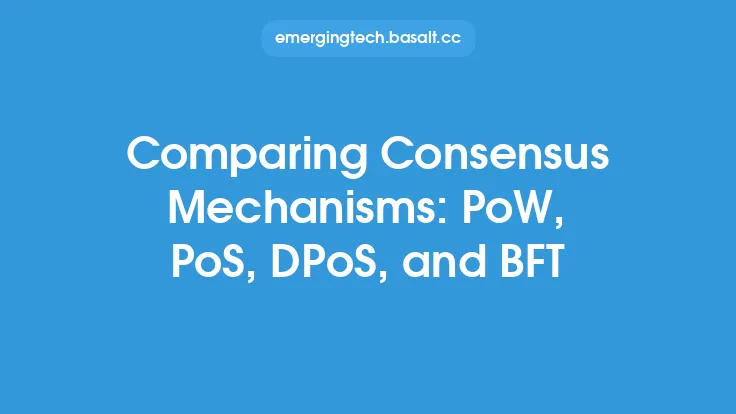The concept of consensus mechanisms is fundamental to the operation of blockchain technology. At its core, a blockchain is a distributed ledger that records transactions across a network of computers. However, for this ledger to be trustworthy and for the network to agree on the state of the blockchain, a consensus mechanism is required. This mechanism ensures that all nodes on the network have the same version of the blockchain, preventing fraud and ensuring the integrity of the data.
What are Consensus Mechanisms?
Consensus mechanisms are algorithms used by blockchain networks to achieve agreement among nodes on the state of the blockchain. This agreement is crucial because it prevents a single entity from manipulating the blockchain, thereby ensuring the security and trustworthiness of the network. Without a consensus mechanism, a blockchain would be vulnerable to attacks and would not be able to function as intended. Consensus mechanisms essentially solve the problem of how to get a group of nodes to agree on a single version of the blockchain, even in the presence of malicious actors.
Types of Consensus Mechanisms
There are several types of consensus mechanisms, each with its own strengths and weaknesses. The choice of consensus mechanism depends on the specific needs of the blockchain network, including factors such as security requirements, scalability needs, and energy efficiency. Some of the most well-known consensus mechanisms include Proof of Work (PoW), Proof of Stake (PoS), Delegated Proof of Stake (DPoS), and Byzantine Fault Tolerance (BFT). Each of these mechanisms has its own approach to achieving consensus, ranging from complex mathematical puzzles to voting systems based on the amount of cryptocurrency a node holds.
Importance of Consensus Mechanisms
Consensus mechanisms are critical to the functioning of blockchain networks. They ensure that the blockchain remains secure, trustworthy, and resistant to manipulation. Without a robust consensus mechanism, a blockchain network would be vulnerable to a variety of attacks, including double-spending attacks, where a user attempts to spend the same cryptocurrency twice. Consensus mechanisms also play a key role in preventing the blockchain from being altered or deleted, ensuring the permanence of the transactions recorded on it.
How Consensus Mechanisms Work
The process of achieving consensus varies depending on the specific mechanism used. However, most consensus mechanisms involve a series of steps that ultimately lead to nodes on the network agreeing on the state of the blockchain. This typically involves the creation of new blocks of transactions, the verification of these blocks by nodes on the network, and the addition of the verified blocks to the blockchain. The specifics of how this process occurs can vary significantly between different consensus mechanisms, reflecting the diverse approaches to achieving consensus in a decentralized network.
Challenges and Limitations
While consensus mechanisms are essential for the operation of blockchain networks, they also present several challenges and limitations. One of the main issues is scalability, as many consensus mechanisms are not designed to handle a large number of transactions per second. This can lead to slow transaction processing times and high fees, limiting the usability of the blockchain. Additionally, some consensus mechanisms, such as Proof of Work, are energy-intensive, contributing to significant environmental impacts. These challenges highlight the need for ongoing innovation and development in the field of consensus mechanisms.
Conclusion
In conclusion, consensus mechanisms are a foundational component of blockchain technology, enabling the creation of secure, trustworthy, and decentralized networks. Understanding the principles and types of consensus mechanisms is essential for appreciating how blockchain works and for developing new blockchain-based applications. As the field of blockchain continues to evolve, the development of more efficient, scalable, and sustainable consensus mechanisms will play a critical role in unlocking the full potential of this technology. By exploring the evergreen aspects of consensus mechanisms, we can gain a deeper insight into the underlying principles that make blockchain technology so powerful and versatile.





